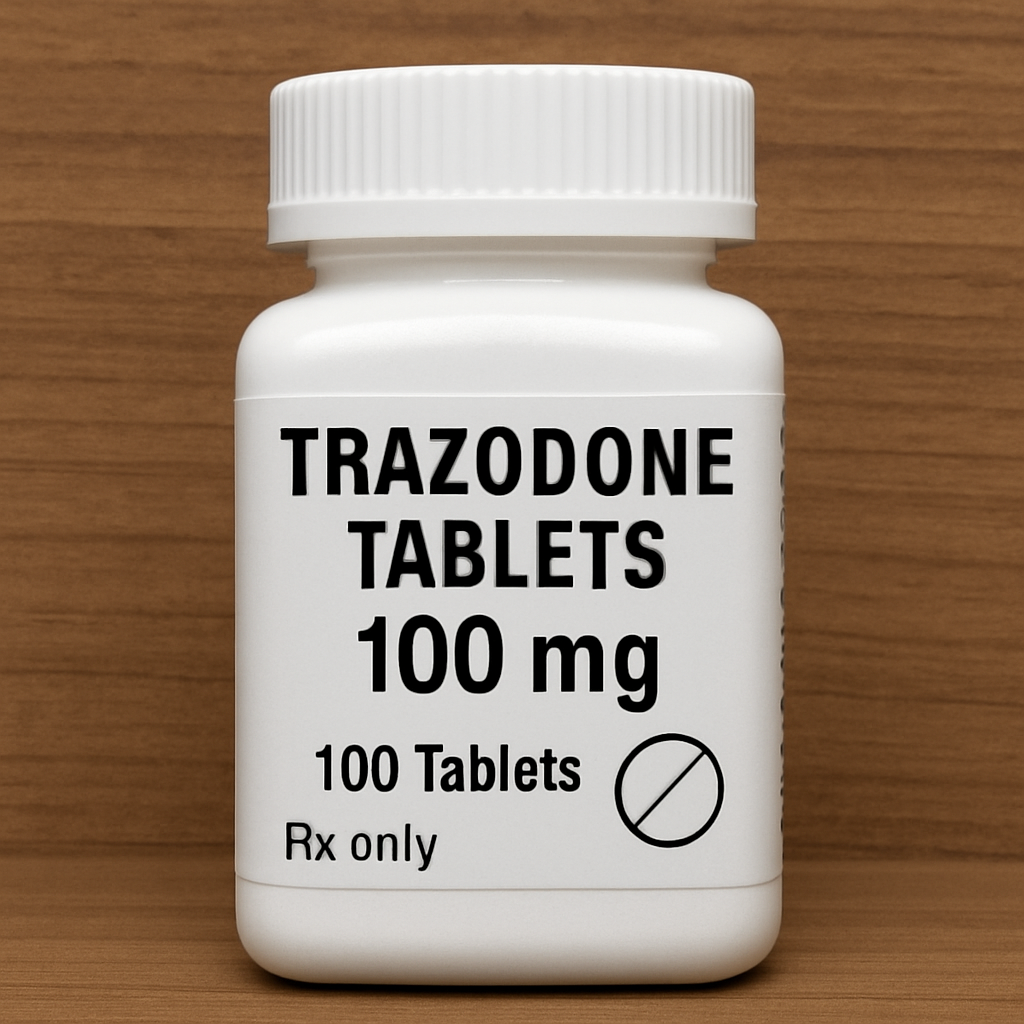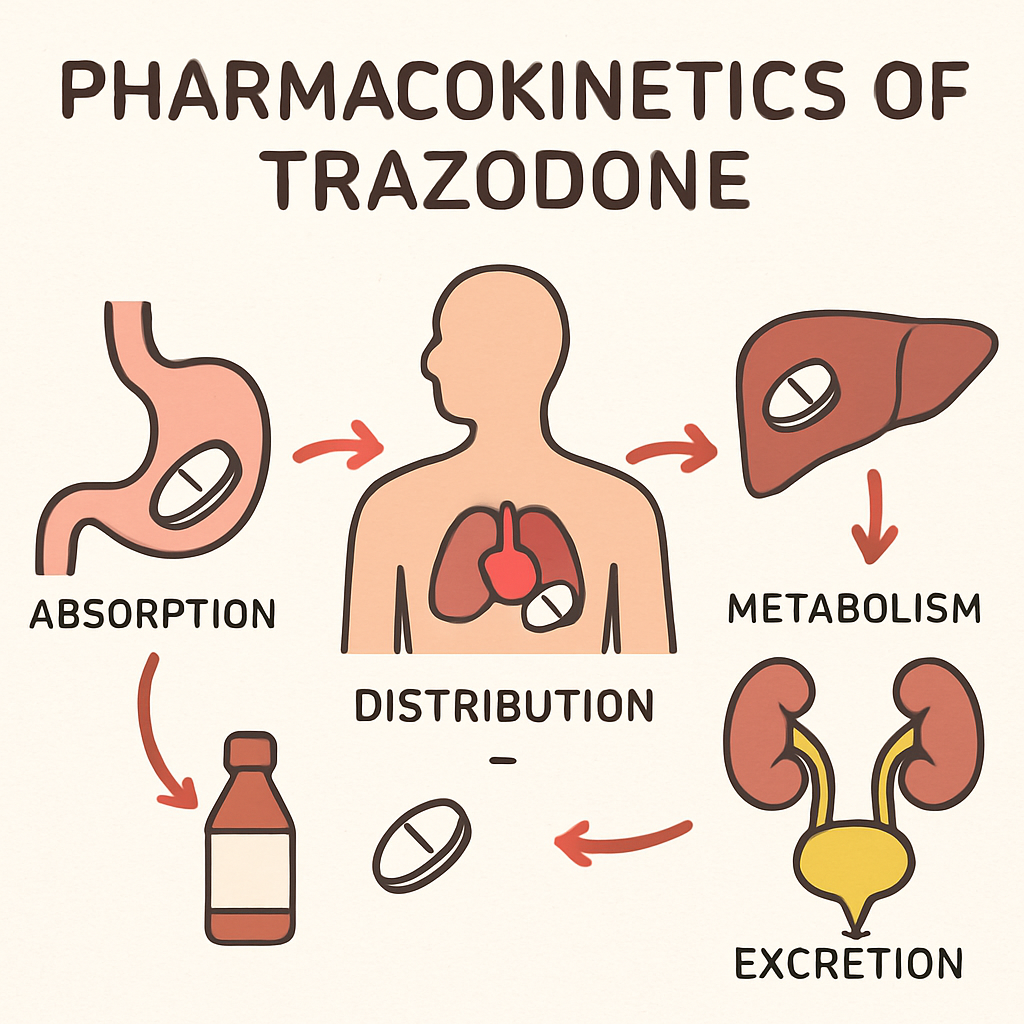
What is Trazodone?
Trazodone is an antidepressant that belongs to a class of drugs known as serotonin modulators. It works by helping to restore the balance of a natural substance (serotonin) in the brain, thereby improving mood, appetite, and energy levels while decreasing anxiety and insomnia related to depression.
Mechanism of Action
Trazodone primarily targets serotonin receptors in the brain. By inhibiting the reuptake of serotonin, it increases its availability in the synaptic cleft, thereby enhancing mood and emotional stability. This mechanism is similar to other antidepressants, but trazodone’s unique receptor profile provides additional benefits like sedation.
Benefits Beyond Depression
While it’s primarily used to combat major depressive disorder, trazodone’s benefits extend to addressing anxiety disorders, including generalized anxiety disorder and panic attacks. Its impact on serotonin levels can help mitigate the overwhelming feelings associated with these conditions, providing a more balanced emotional state.
Historical Context
Introduced in the 1960s, trazodone was initially developed as a safer alternative to tricyclic antidepressants. Over the decades, its use has expanded beyond just treating depression, as clinicians recognized its effectiveness in addressing sleep disorders and anxiety, making it a multifaceted tool in mental health care.
Trazodone Usage
Trazodone is primarily used to treat major depressive disorder. However, due to its sedative properties, it is also often prescribed off-label to treat insomnia. The versatility of trazodone makes it a popular choice among healthcare providers for patients dealing with depression and sleep disorders.
Off-Label Uses
Aside from insomnia, trazodone is sometimes used off-label for conditions like fibromyalgia and chronic pain syndromes. Its ability to improve sleep quality can indirectly help manage pain by ensuring the body gets the rest it needs for recovery and repair.
Combination with Other Treatments
Trazodone is often used in combination with other antidepressants or mood stabilizers to enhance therapeutic outcomes. For patients who do not fully respond to monotherapy, adding trazodone can augment the antidepressant effects and provide additional benefits like improved sleep.
Patient Considerations
When prescribing trazodone, healthcare providers must consider patient-specific factors such as existing health conditions, current medications, and individual response to treatment. These considerations ensure that trazodone is both safe and effective for the patient’s unique needs.
Understanding Half-Life
The term “half-life” refers to the time it takes for half of a drug’s active substance to be eliminated from the body. Understanding the half-life of trazodone is essential for determining how often the medication needs to be taken and for avoiding potential side effects related to improper dosing.
Importance in Medication Management
Understanding the half-life is crucial in preventing drug accumulation, which can lead to toxicity. By knowing how long the medication stays active, healthcare providers can design dosing schedules that maximize therapeutic benefits while minimizing adverse effects.
Factors Affecting Half-Life
Several physiological factors can influence the half-life of trazodone, including genetic differences in metabolism, concurrent use of other medications, and overall health status. These factors can lead to variations in how quickly or slowly the drug is processed in the body.
Role in Tapering
When discontinuing trazodone, understanding its half-life is essential for tapering the medication safely. Gradual reduction helps prevent withdrawal symptoms and allows the body to adjust to the absence of the drug, ensuring a smoother transition off the medication.

Trazodone Dosing
The dosing of trazodone can vary widely depending on the condition being treated. For depression, the typical starting dose is around 150 mg per day, which can be adjusted by the healthcare provider based on the patient’s response and tolerance. When used for insomnia, lower doses, such as 25 to 100 mg at bedtime, are common.
Initial Dosage Considerations
Starting doses are often conservative to assess tolerance and minimize side effects. Patients are usually started on a lower dose, which is gradually increased based on therapeutic response and tolerance. This approach helps in minimizing the risk of adverse effects.
Long-Term Dosage Adjustments
Over time, the body may develop a tolerance to certain doses, necessitating adjustments. Regular follow-ups with a healthcare provider ensure that the medication remains effective and any necessary changes in dosage are made to maintain optimal therapeutic effects.
Special Populations
Certain populations, such as the elderly or those with liver impairment, may require special dosing considerations. These groups often metabolize drugs differently, necessitating tailored dosing strategies to prevent accumulation and potential toxicity.
Effects of Trazodone
Trazodone has several effects on the body, which can be both therapeutic and adverse. Understanding these effects is important for ensuring safe use.
Therapeutic Effects
The primary therapeutic effects of trazodone include mood improvement, anxiety reduction, and better sleep. These effects result from the medication’s ability to modulate serotonin levels in the brain, which can enhance overall mental well-being.
Mood Enhancement
Patients often report improved mood and a decrease in feelings of sadness and hopelessness. This is primarily due to trazodone’s effect on serotonin, which plays a critical role in mood regulation.
Anxiety Reduction
Trazodone’s calming properties help reduce anxiety, providing a sense of relief from constant worry and tension. This can be particularly beneficial for individuals with anxiety disorders who also suffer from sleep disturbances.
Sleep Improvement
Trazodone’s sedative effects make it an effective treatment for insomnia, helping patients achieve better sleep quality and duration. Improved sleep can have a profound impact on overall health and well-being, as it allows for better daily functioning and mood stabilization.
Side Effects
Like any medication, trazodone can cause side effects. Common side effects include drowsiness, dizziness, dry mouth, and blurred vision. More serious side effects, though rare, can include changes in heartbeat, fainting, and prolonged erection (priapism). Patients should report any concerning side effects to their healthcare provider promptly.
Common Side Effects
Drowsiness and dizziness are among the most reported side effects, especially when starting the medication. Patients are advised to be cautious when performing activities that require alertness, such as driving, until they understand how trazodone affects them.
Managing Side Effects
Most side effects tend to diminish over time as the body adjusts to the medication. However, if side effects persist or become bothersome, healthcare providers may adjust the dosage or suggest coping strategies to mitigate them.
Rare but Serious Side Effects
While rare, some side effects require immediate medical attention. Priapism, a prolonged and painful erection, is a medical emergency that necessitates urgent care. Additionally, any significant changes in heart rhythm or fainting episodes should be promptly evaluated by a healthcare professional.

by Andrey Khoviakov (https://unsplash.com/@khoviakov)
Factors Influencing Trazodone Half-Life
Several factors can influence how trazodone is metabolized and eliminated from the body.
Age and Metabolism
Older adults may process trazodone more slowly due to changes in metabolism and liver function. This can lead to a longer half-life, necessitating adjustments in dosing to prevent accumulation in the body.
Metabolic Changes with Age
As individuals age, their metabolic rate tends to slow down, impacting how quickly medications are processed. This can result in longer drug retention, requiring careful monitoring and potential dose adjustments.
Implications for Elderly Patients
For elderly patients, the risk of side effects and drug interactions is higher due to the prolonged presence of trazodone in the system. Healthcare providers must tailor dosing regimens to ensure safety and efficacy in this population.
Monitoring and Follow-Up
Regular monitoring of liver function and overall health is crucial for older adults taking trazodone. This helps in identifying any changes in drug metabolism early, allowing for timely interventions and dosage adjustments.
Liver Function
Since trazodone is metabolized in the liver, individuals with impaired liver function may experience a prolonged half-life of the medication. Regular monitoring and dosage adjustments are critical for these patients to avoid potential toxicity.
Liver Impairment Considerations
Patients with liver impairment may require significantly lower doses of trazodone. Regular liver function tests help in assessing how well the liver is processing the medication and in preventing potential complications.
Drug Interactions
Certain medications can affect liver enzymes, altering how trazodone is metabolized. It’s important for patients to inform healthcare providers of all medications they are taking to avoid adverse drug interactions.
Adjusting Treatment Plans
For patients with compromised liver function, treatment plans must be flexible. Dosage adjustments and regular monitoring ensure that the therapeutic benefits of trazodone are achieved without increasing the risk of adverse effects.
Importance of Adhering to Prescribed Regimen
Adhering to the prescribed trazodone regimen is crucial to achieving the desired therapeutic effects and minimizing side effects. Patients should be consistent with their dosing schedule and communicate with their healthcare provider about any concerns or side effects they experience.
Consistency in Dosing
Taking trazodone at the same time each day helps maintain stable drug levels in the bloodstream, enhancing its effectiveness. Consistency reduces the risk of fluctuations that could lead to reduced efficacy or increased side effects.
Communicating with Healthcare Providers
Open communication with healthcare providers is essential for managing side effects and adjusting treatment plans. Patients should feel comfortable discussing any concerns or changes in symptoms to ensure optimal care.
Avoiding Abrupt Discontinuation
Stopping trazodone abruptly can lead to withdrawal symptoms, including anxiety, agitation, and sleep disturbances. Patients should always consult their healthcare provider before making any changes to their medication regimen to ensure a safe and gradual discontinuation process.
Conclusion
Understanding the half-life of trazodone and its implications on dosing and effects is vital for managing depression and associated disorders effectively. By following the guidance of healthcare providers and adhering to prescribed dosages, patients can optimize the benefits of trazodone while minimizing potential risks. Always consult with a healthcare professional before making any changes to your medication regimen.



